Euphorbia Trigona: Caring for African Milk Tree (Euphorbia Cactus / Candelabra Cactus)
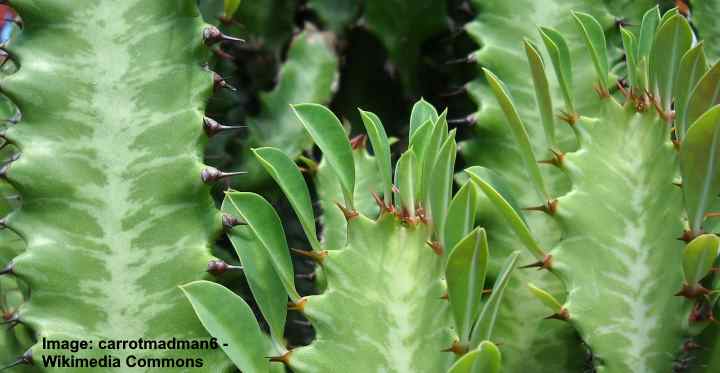
The Candelabra cactus (Euphorbia trigona or Euphorbia cactus) is a type of succulent, not a true species of cactus. Also called the African milk tree, this plant is a tall-growing branching succulent. This leafy cactus-like succulent has a central stem with branches that grow upward. Along the ridges of the stems are thorns and small oval-shaped leaves.
To care for the Euphorbia trigona: The Euphorbia cactus thrives when growing in filtered bright light, well-draining potting soil, and low to average humidity. Water the succulent when the soil dries. The minimum temperature is 55°F (12°C). Apply a balanced fertilizer monthly during the growing season.
The Euphorbia cactus is a perennial, evergreen succulent native to Central Africa. Growing outdoors, the African milk tree has dense growth and grows into a bush-like spiky plant—which is also called the African milk bush. At maturity, the Euphorbia cactus reaches up to 6 ft. (1.8 m) in height.
Other common names for Euphorbia trigona include the good luck cactus, cathedral cactus, friendship cactus, dragon’s bones, the high chaparral plant, and Abyssinian Euphorbia.
This species of Euphorbia succulent is popular with many houseplant owners because it looks like a cactus. The houseplant’s tall growth and ability to grow in partial shade makes it excellent for adding greenery to corners of rooms. Some spectacular Euphorbia cacti have deep red leaves. The Euphorbia trigona Rubra or Royal Red Euphorbia creates a dramatic visual statement.
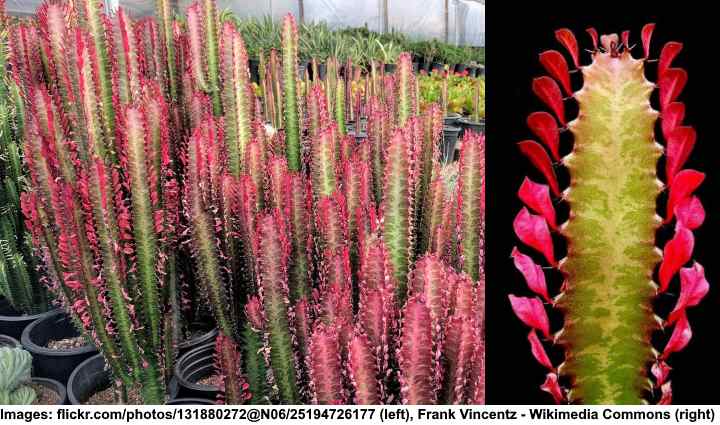
Euphorbia trigona ‘Rubra’
The Euphorbia cactus rarely flowers outdoors and never indoors.
In this comprehensive guide to Euphorbia trigona care, find out how to make the plant thrive.
Why Euphorbia Trigona (Euphorbia Cactus) Is Not a Cactus
Euphorbia trigona is a type of succulent and isn’t classified as a cactus. This Euphorbia species grows leaves—which almost no cactus does. Second, this cactus-like plant exudes a toxic milky-white sap when cut, which is typical to a Euphorbia.
Despite its common names—Euphorbia cactus, hat-rack cactus, African milk cactus—the plant is from the succulent family Euphorbiaceae. The plant’s cactus names come from its tall, upright growth and its thorns that emerge from the corners of the stems.
Looking at pictures of the Euphorbia cactus, it has a similar growth habit to the saguaro cactus – both are identified by a tall, straight central stem with upward-growing branches that look like arms.
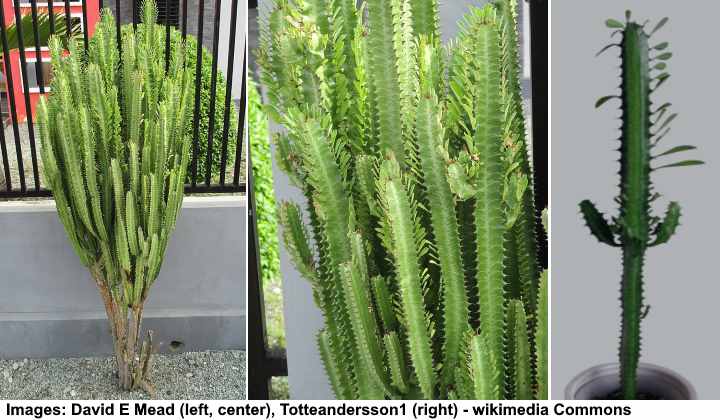
Although Euphorbia Trigona looks like a cactus or a little tree/shrub, it is classified as a succulent
Why the Euphorbia Cactus is Called African Milk Tree
The Euphorbia trigona gets its common name ‘African milk tree’ from the toxic white sap in its stems. Many species of succulents in the genus Euphorbia have this milky latex substance. Cutting or puncturing the plant causes milk to leak. Some people mistakenly call this substance cactus sap.
Why is this plant that looks like a cactus called a tree? In their native environment, Euphorbia trigona grows as tall as 8 or 9 ft. (2.4 – 2.7 m). Pictures of full-grown Euphorbia cacti look like large, bushy trees. Also, their shape, like an up-turned candelabra, is a reason why the “trees” are also called candelabra cactus.
If you are planning on growing a Euphorbia cactus at home, you don’t have to worry about its enormous height. Growing in a pot helps restrict its indoor growth. It is also easy to prune the spiky succulent stems to grow more indoor “trees.”
Euphorbia Trigona is an Easy to Grow Plant
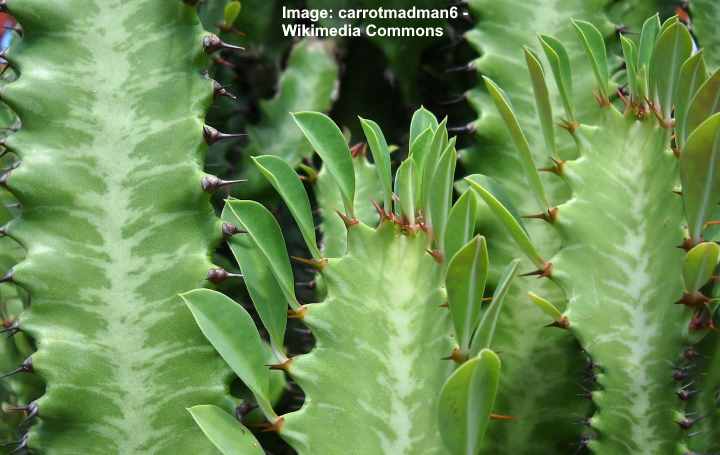
Euphorbia Trigona is an easy to grow low maintenance houseplant
The tall-growing Euphorbia succulent is easy to grow indoors. For your branching succulent to thrive, all you need is a heavy, unglazed clay pot to support this indoor tree like plant, and well-draining, sandy soil. As with most succulents, they can go for a few weeks without any water.
When you get the potting soil mix and watering frequency right, you can put the plant in a bright spot, protected from direct sunlight, and almost forget about it.
Euphorbia Cactus Flowers
Rarely, the Euphorbia trigona produces small white or yellow-white flowers. The tiny Euphorbia cactus flowers are relatively insignificant compared to the long upward stems. However, it’s highly unlikely that Euphorbia cacti bloom indoors—even under ideal growing conditions.
How to Care for Euphorbia Trigona (Euphorbia Cactus or Candelabra Cactus)
Although Euphorbia cactus isn’t a real cactus, you care for it similarly as you would look after a cactus plant.
Candelabra Cactus Light Requirements
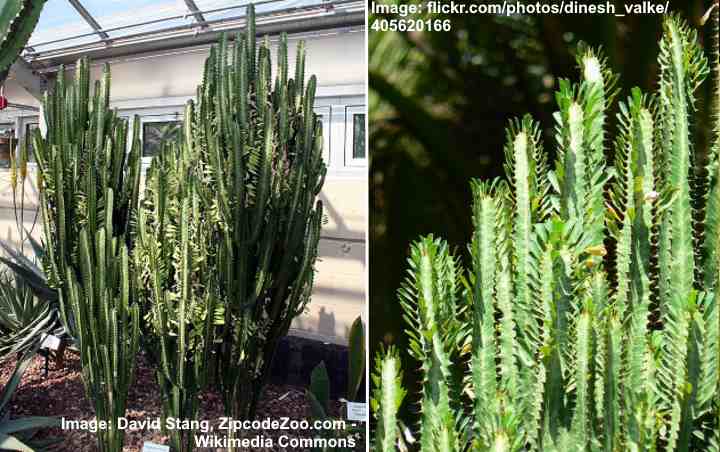
Euphorbia Trigona succulents grow well in a bright indirect light
Place your Euphorbia cactus in a bright spot where it gets plenty of indirect sunlight. The tall, upright candelabra cactus grows well near a south-facing window but protected from direct sun that can burn the plant. Euphorbia succulents also thrive in partial shade in an east- or west-facing room. The Euphorbia needs at least four hours of bright sunlight daily.
During long hot summers, the candelabra cactus may need some protection from full sun. If you notice that the plant is stressed from the hot sun, move it to a shadier place. If you have the red species of succulent—Euphorbia trigona ‘Rubra’—you will find that plenty of sunshine helps to keep the leaves a deep red color.
The candelabra cactus grows best in bright light. But you may find that it adapts well to shaded areas or darker places—for example, north-facing rooms. However, without adequate light, the Euphorbia trigona’s growth becomes thin. Also, a lack of light may cause the succulent stems to darken in color.
How to Water Euphorbia Cactus
A Euphorbia cactus doesn’t need much water. Only water the cactus like plant whenever the soil dries out. In the summertime, you may only have to water the plant every ten to 14 days. In winter, you’ll rarely have to water the succulent at all.
To know when to water a Euphorbia trigona, check the top 2” (5 cm) of soil for moisture. If there are any signs of dampness, you’ll need to wait. As with watering types of cacti, the soil should dry between watering. The worst thing you can do to succulents or cacti is to let their roots sit in soggy soil.
To water candelabra cactus plants, pour enough water in until it drains from holes in the pot’s base. This type of deep watering ensures the roots get appropriately hydrated. Allowing all the excess water to drip out also makes sure that too much moisture doesn’t stay in the pot.
An unglazed terracotta pot is the best kind of container for growing a Euphorbia cactus. The weight of the pot helps keep the plant steady—essential when the Euphorbia grows tall. Also, moisture evaporates faster from clay pots than plastic ones. This type of container for succulents prevents soil from staying too damp.
The good news is that Euphorbias are a drought-tolerant type of houseplant. So, you can leave them for a few weeks without water. Remember—it is better to underwater cacti and succulents, rather than overwater them. Your Euphorbia will thank you for a bit of neglect.
The Ideal Potting Soil for Euphorbia Cactus
All species of succulents—including Euphorbia trigona—must grow in sandy cacti soil with excellent drainage. Create a growing medium for cacti and succulents by mixing one-part peat moss and one-part perlite. Or, you can use a suitable cactus mix for growing Euphorbia succulents.
The candelabra cactus is an easy-to-grow houseplant when you grow it in the right soil. A sandy, loamy potting soil that allows water to drain fast is ideal for these plants. If the soil is too dense, you could add pumice or perlite to increase aeration. A light, aerated soil also allows the Euphorbia cactus roots to have enough oxygen for healthy growth.
Getting the two essential Euphorbia trigona care requirements right, means you’ll have a succulent that grows well. The two factors are:
- Growing Euphorbia cactus in a well-draining potting mix
- Watering the cactus-like succulent only when the soil dries
Temperature Requirements for Growing Euphorbia Cactus
Average room temperatures are ideal for growing African milk plants indoors. The Euphorbia houseplant thrives in a room temperature range of between 64°F and 78°F (18°C – 26°C). The minimum temperature that Euphorbia cacti grow is 55°F (12°C). Protect the African milk cactus from cold drafts in winter.
Growing outdoors, the multi-stemmed succulent feels at home in hot, arid climates. You can also plant Euphorbia cactus plants in your backyard if you live in USDA zones 11 and above. In temperate climates, you can take the potted Euphorbia cactus outside in summer. Remember to bring it back indoors when the temperature drops to 55°F (12°C). The succulent could suffer if it’s left out below 50°F (10°C).
Although candelabra cactus plants grow well in most indoor conditions, they need plenty of air movement. During summertime, ensure there is good air circulation near the plant. However, avoid allowing the potted cactus like plant to stand in a cold draft or air-conditioning airflow.
Humidity for Euphorbia Cactus
African milk plants (Euphorbia trigona) don’t have any special humidity requirements. Average room humidity levels are ideal. The Euphorbia’s love of dry air means that you don’t need to mist its leaves. As long as you only hydrate the soil when it dries and place the plant in bright sun, it will thrive without extra humidity.
As with growing most succulents and cacti at home, too much humidity can be their downfall. Overly-humid conditions can result in problems that put your cathedral cactus under stress. Some issues associated with excessive air moisture are root rot, fungal disease, or houseplant pests.
Euphorbia Trigona Cactus Growth Rate
Candelabra cactus plants have a relatively slow growth rate in containers. As a houseplant, the Euphorbia trigona can eventually grow to 6 ft. (2 m). But you can easily control its height by pruning the tops off the stems. Of course, Euphorbia cactus growth is faster in spring and summer than during its dormant period in winter.
Fertilizer for Euphorbia Cactus
Fertilize Euphorbia cactus with a diluted water-soluble fertilizer for succulents or cacti. Apply the fertilizer solution every three to four weeks during the growing season—spring and summer. Don’t provide fertilizer when the plant stops growing in fall and winter.
To ensure healthy and rapid Euphorbia trigona growth, flush the soil every two to three months during the growing season. Thoroughly drenching the soil helps rinse away excess minerals that can build up in the soil. All you need to do is run water through the potting mix for a minute or two and allow it to drain completely.
How to Propagate Euphorbia Cactus
Use stem cuttings to propagate Euphorbia trigona plants. To propagate the succulent, just cut a 3” to 4” (7.5 – 9 cm) section from the top of a stem. You can then plant the newly-cut stem in fresh potting mix, and it will start taking root after three weeks.
One thing to remember when propagating candelabra cactus is to use protective gear. Before handling the plant, put on heavy-duty gloves, goggles, and cover exposed areas of skin. Using protection when propagating these succulents will protect you from the irritating milky sap in the plant’s stems.
Instructions on how to propagate Euphorbia trigona:
- Put on protective gloves and goggles.
- Using sharp, sterile pruning shears, cut off an arm from the base of the main stem.
- Rinse both the cut sections of the plant with clean water, making sure not to let the “milk” splash on your skin.
- You can either plant the cut stem in fresh potting soil or allow it to dry for two days to callus over.
- Keep the potting soil moist for two to three weeks until the cut stem takes root.
- After that, care for your Euphorbia trigona as usual.
The hardy succulent stems root quickly, and you can soon grow new plants.
Repotting Candelabra Cactus (Euphorbia Trigona)
Transferring an African milk plant to a new pot is relatively straightforward. Due to the plant’s growth, there are a few things to keep in mind when repotting. For example, you need to protect yourself from skin contact with the toxic sap. Also, you need to protect the long thorny stems from puncturing each other and your skin.
Instructions to repot Euphorbia trigona:
- Put on protective clothing and suitable gloves.
- Crumple pieces of newspaper and put between the stems.
- Lightly tie the stems together with string to prevent them from falling and breaking.
- Run a flat knife around the inside edge of the pot to loosen the soil.
- Gently remove the African milk plant from its container. It may be easier to lay tall plants on their side to do this.
- Take a new container that is one to two sizes larger than its current one and fill it half-full with a cactus mix potting soil.
- Carefully put the plant in the new pot and fill the remaining space with potting soil.
- Wait for two weeks after repotting until you water the plant.
Pests Affecting Euphorbia Cactus Growth
Mealybugs and scale insects are two types of pests that can infest candelabra cactus plants. These sap-sucking pests feed on the juices of your plant and can affect its growth. Learn how to spot the signs of common houseplant pests to keep plants healthy and thriving.
- Mealybugs—Look for signs of mealybugs on Euphorbia cacti, such as white fuzz or a cotton wool-like substance. Use a natural neem oil spray to get rid of mealybugs for good.
- Scale insects—Scale looks like bumps or weird growth on African milk plants. The plant-destroying pests generally don’t move but attach themselves to the plant and suck the sap. Find out how to use alcohol to get rid of scale pests from succulents.
Diseases Affecting Euphorbia Cactus Growth
Root rot caused by overwatering is a common disease that can kill candelabra cactus plants. The best way to avoid fungal houseplant diseases is to avoid watering too often. Only water Euphorbia cactus plants when the top layer of soil is completely dry.
If your Euphorbia trigona has brown, soft stems or limbs, it’s probably a sign of rot. Trim off the dying stems and dispose of in the trash—don’t compost them. Hold off watering until the potting soil of African milk cactus dries. In a worst-case scenario, you may have to repot the succulent in fresh potting mix to save it from dying.
Related: Amazing Tall Indoor Plants (Pictures)
FAQs About Growing African Cactus (Euphorbia Trigona) at Home
Is Trigona Euphorbia poisonous?
Yes, Euphorbia trigona contains a milky poisonous latex. Medical reports say that its toxic white sap can cause skin inflammation, irritation, and burning. There are reported cases of Euphorbia sap causing vision problems and even blindness if it gets into the eyes.
Do all euphorbias have milky sap?
Many species of plants in the genus Euphorbia have this white sticky sap that irritates the skin, mucous membranes, and the eyes.
Are Euphorbia trigona plants toxic to animals?
Veterinary experts say that many succulents in the genus Euphorbia are toxic to dogs and cats. They advise you to avoid having any type of euphorbias at home if you have pets.
Related articles:
- Amazing Types of Succulents (With Pictures)
- Haworthia Cooperi: Care Guide For The Transparent Succulent
- Haworthia Fasciata (Zebra Plant) Succulent: Care and Growing Guide
